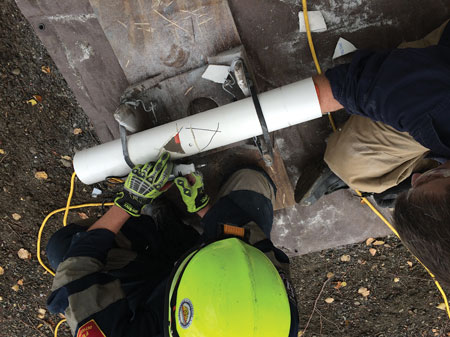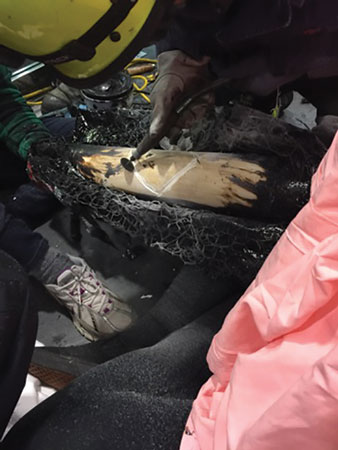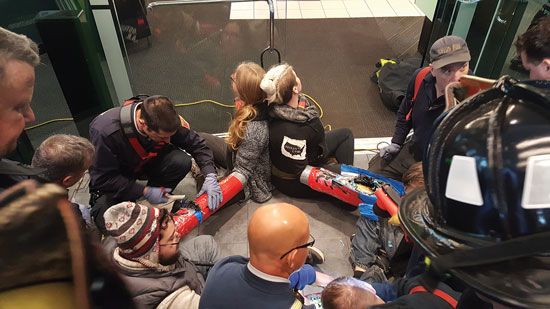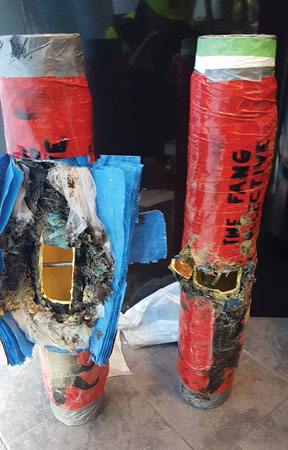
By Thomas F. Kenney
I recently participated in the “Field Force Extrication Tactics,” developed by the U.S. Department of Homeland Security. It specifically deals with the devices protestors use to immobilize, connect, and block in violation of the law. Protest threats; legal considerations; types of devices; and, most interestingly, the extrication team are discussed. The majority of fire departments carry the extrication tool assortment needed to defeat the devices used by protestors. This portion of the class is the focus of this article.
 |
| (1) Photos by author unless otherwise noted. |
Materials such as polyvinyl chloride (PVC), steel, and concrete are the common components of protestors’ devices. Purposeful entrapment in these devices does not pose the urgency commonly seen in accidental entrapment. The major reason for this is that these are nontraumatic events. They should remain that way until extrication has been completed. There is clearly the potential for injury if the protestors are moved while they are connected to each other by these devices; in some cases, they may be anchored to immovable objects such as a building or a guardrail.
 |
| (2) Photo by Edgar Rodriguez. |
Once the protesters have been placed under arrest and searched and the scene has been made safe, then the safety of the extrication team and the protester is paramount. The type of device and its construction material will determine the type of tool and the method of attack used to defeat the device. Again, there is no urgency in releasing the protestors. Employ safety measures such as eye and hearing protection for the extrication team and protective covering of the protesters during operations. Also be prepared with methods for cooling the device or the anatomy of a protester and controlling sparks during metal cutting.
Sleeping Dragon Devices – PVC
The sleeping dragon, constructed from PVC pipe (photo 1), is a device commonly used by protestors. Two or more individuals can be connected; the method of attachment (chain or webbing, for example) is shielded by the plastic pipe. A bolt or threaded rod is placed through the center of the pipe. The rod has the nuts on the inside to slow down or prevent disassembling the rod without cutting. The protester is connected to the bolt or rod with chain around the wrist and terminated with a snap link or a carabiner. The protester can connect or disconnect inside the pipe, but the connection is not accessible from the outside without cutting the pipe. Additions to the PVC pipe may include duct tape or duct tape over chicken wire or tar, animal waste, or human waste. The PVC pipe coverings are intended to slow down the cutting process by soiling tools (photo 2).

Stabilization must be the first step in disassembly. Once accomplished, remove the outer layer of tape and expose any contaminants or wire reinforcement – using a utility knife followed by a pair of tin snips will suffice. Once the PVC is exposed, scrape away the contaminant to expose a clean spot to make the inspection/release hole. You can cut the PVC pipe with the angle grinder; small, electric rotary saw; or whizzer saw. Make the diamond or triangle inspection cut as near to the bolt as possible; the opening should be large enough to accommodate a bolt cutter. If there is no evidence that a bolt is present, the connection may be one protester to another. Either way, make the initial cut without piercing all the way through the PVC. The kerf should leave a slight film at the deepest part of the cut with adequate overlap on intersecting cuts. Then, pop out the piece with a small pry bar and pliers (photo 3). The shallow cuts prevent the saw blade from potentially entering the inside of the pipe and injuring the protester. Once the piece is popped out, hook the chain into a bolt cutter and sever it, or cut the bolt itself.

Another option if the bolt head is exposed at the pipe surface is to cut only the bolt head with a reciprocating saw, a band saw, or an angle grinder. Depending on how the bolt is nutted on the inside, this may be enough to make the release. Again, make shallow, controlled cuts for the safety of the protester.
Sleeping Dragon Devices in Concrete
In addition to PVC and steel pipes, protestors have encased the sleeping dragon devices in concrete (photos 4-5). Forms such as a five-gallon pail, a 55-gallon drum, or a cardboard tube filled with concrete may be used, and protesters have been known to add cloth, screws, or nails to delay extrication. To defeat these devices, you will need breaching and breaking tools such as chipping hammers, hammer drills, and breakers and the finesse to defeat the form and the concrete component without injuring the protester. Once the pipe portion of the device has been reached, cut the inspection hole in the pipe to enable you to cut the pin or the connection to the pin.

Steel Pipe
This same type of protester device can also be constructed using steel pipe with a welded-in-place pin (photo 6). The principle of defeating the device is the same, but gasoline or electric rotary cut-off saws, a band saw, and an angle grinder become the primary tools. The wall thickness of the pipe will help determine the cutting tool. Remember that the cuts should not be made all the way into the hollow of the pipe. Make every effort to leave a thin layer so you can pry out the piece of pipe. Be sure to overlap intersecting cuts (photo 7). Maintain control of potential heat transmission by cooling with water, and control sparks from saws and grinders.

Unlike a traumatic unintentional entrapment, time is on our side in these types of events. In protestor extrication, we will use many of the same techniques we employ during rescue operations to save a life or limb. These incidents may involve using many variations of our tools from simple hand tools such as a utility knife, tin snips, pliers, and a screwdriver to power tools including saws, hammer drills, and breakers. The decisions relative to tool groups, blade choice, and tool size will be made based on the type of device encountered and the environment in which you are working. Safety of our members and the protesters remains a priority. Establishing and following a rescue plan, knowledge of tool groups and their capabilities, and mastery of tool operations are needed for successful outcomes in these unusual operations.

Within one week of completing this class, members of Boston’s Special Operations Command were called to operate at a protest in downtown Boston. A group of protesters had blocked the entrance of a bank. The protesters used PVC tar dragons to connect to each other and, in addition, bicycle locks around their necks to connect to the bank door (photo 8). The Boston Police Department afforded the protesters the opportunity to self-release and leave. They refused. They were placed under arrest, and the scene was secured for extrication operations. Members of Rescue Company 1 used hand and power tools to overcome the devices without injuring the protesters (photo 9).
 |
| (8-9) Photos by John Forristall, Boston (MA) Fire Department. |
THOMAS F. KENNEY is a captain with the Hyannis (MA) Fire Department, where he has served for 34 years. He is a rescue team manager and a collapse rescue instructor with the Department of Homeland Security/FEMA and MA-TF1. He is a partner in Heavy Rescue Incorporated, a fire service training company, and has lectured and taught nationally for more than 20 years.

Thomas F. Kenney will present “Rescue Tools: The Must Haves and the Nice to Haves” at FDIC International in Indianapolis on Thursday, April 27, 2017, 10:30 a.m.-12:15 p.m.
Safe Response to Civil Unrest Incidents
EFFECTIVE EMERGENCY PLANNING FOR COLLEGES AND UNIVERSITIES
Fire Engineering Archives

